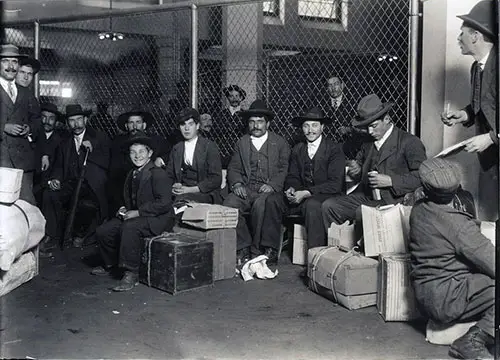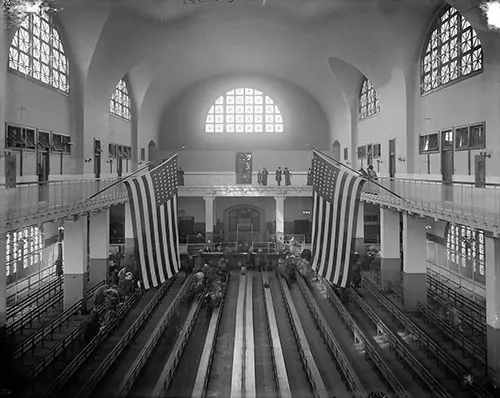The New Ellis Island - Improvements for the Arriving Immigrants

(Recalling the study on Ellis Island in our last Immigration number (January 1907, our readers will thank us for securing from The Christian City, permission to use this statement of "the new Ellis Island." which it bad culled from the good things of Charities and the Commons—Editor.
There are few places where the social viewpoint is more concretely and widely expressed than at Ellis Island. Changes in process will affect the comfort of a new million of people each year. Commissioner Watchorn is an official who is adequate to an immense situation.
More beds, cleaner quarters, more restaurant tables, a larger restaurant, a new immense baggage room, one level for the entering immigrant instead of forty-two steps up and forty-two steps down under a mountainous backfill of luggage.
Also, additional sanitary detention rooms, an island hospital with five hundred beds where children with measles and insane adults will receive humane and scientific treatment, more skylights for dark corridors—these are a few of the reforms now making.
An analysis of the spirit in which the enlarging program is carried out would show:
- An efficient kindness;
- Executive insight;
- The desire for more light—skylight, daylight, white tiling in place of black pitch-and-tar flooring;
- Increasing centralization and unification—one large dining hall in place of small unconnected rooms;
- One hospital eight hundred feet from the commissioner's rooms, instead of four city subsidized hospitals, two to twelve miles distant.
GENERAL TREATMENT
There is a steady, unremitting, progressively successful attempt made to handle the immigrants with decency and helpfulness. They are not roughly jostled, and herded like cattle—in the way that some New York policemen treat an East Side crowd. Julian A. Dimock, the nature photographer, spent two weeks at Ellis Island in March, photographing types of the various nationalities.
He was unattended and roamed through all the corridors, detention rooms and receiving floors. In fourteen days he saw no single instance of brutality from an attendant to an immigrant.
Of course men on duty grow tired and careless and curt —here as well as in church ushering. But the effort is never relaxed to handle 2,500 and 5,000 persons a day skillfully and kindly.
DORMITORY IMPROVEMENTS
To consider some of the reforms in detail. The main building in its upper story has a set of sleeping compartments in place of the single long corridor dormitory along each flank.
The long dormitory, which visitors will remember as dark and dirty and oppressively gloomy, contained 350 beds, with no walls of separation. The atmosphere was more intense than in a Bowery 10- and 15-cent lodging house. The floor was a mixture of tar and pitch, and was said to be antiseptic.
The only justification for the word was that dirt, spilled on it, was invisible and to that extent nonexistent. The walls were dark—the color of microbes, germs and bacilli. The beds, of iron strips, were anchored to their places. The sleeping compartments, as now arranged, have an average of nine beds in each, where differences in nationality are observed to all possible limits.
The beds are of tightly woven navy canvas, three in a layer and are pulled ceiling high, out of the way of the floor-cleaners, by a ratchet. The steam-heating radiators are set on six to nine-inch bronze pedestals, so that the mop can go under where bread and fruit accumulate.
The flooring is of white vitrified tile, with a nine-inch pitch, leading to a drain. Each compartment has a set of water-closets and washing bowls(in place of the one end of the building).
To each faucet in each compartment, a hose is attached each morning, and hot water is turned on the tile flooring and tile walls. The closets work with a four-minute flush. An overhead six horsepower engine draws out the impure air and drives in cool air, along a galvanized iron duct.
Many of the compartments are already in perfect working order. Enter at 9.30 a. m. and you will see the floor covered with bread-crusts, fruit drippings and lint from the black blankets.
The beds are hoisted, the blankets thrown into navy canvas bags, and the floor and walls steamed and then brushed clean. The window ledges have been built at a steep pitch so that fruit and refuse are no longer piled there as in former days.
At the north and south ends of this dormitory floor, four more compartments will be constructed—two at each end—with a total of 104 added beds.
On what is now the receiving floor, a forty-foot width and the full length will be partitioned off for beds, so that the present central portion of the main building will contain clean sleeping quarters for 1,000 to 1,200 women and children, a gain of 400 beds.
There will be occasional small compartments, where an entire family can be lodged, without the present grievous separation for the first night in a new land. Legitimate sentiment has been considered at every turn, whenever it could be expressed in terms of economical building laws.
NEW BAGGAGE ROOM
The present baggage room is on the ground floor of the main building and consumes valuable space at the expense of human comfort. The immigrants climb forty-two steps to the examining floor, and then descend the same distance, after admittance, with their bags and babies.
With the new building in working order the immigrant will pass through a covered way to the main building on the ground floor for his examination, and will continue through to the new building where his baggage is handled from the barges in an endless chain and will keep on at the same level to the barges at the cribbing on the west. where he will embark for his railroad port.
This holds for ninety per cent. of all arrivals. The ten per cent. of detained cases will be lifted by elevators to their rooms of detention. For New York baggage, an electric railway is planned. There will be space for fifty inspectors instead of for the present twenty-two.
The corridor leading from the examining room to the inquiry room is long and unlighted. Two skylights are being built. The inquiry room, which was open and noisy, has been partitioned off in oak and glass, with a wooden floor, five inches above the black tar and pitch floor.
OTHER CONVENIENCES

Three dining rooms have been in operation. at different points, necessitating the sorting of food. and the food itself served at reduced temperature. Six hundred has been the seating capacity.
At extraordinary times, 3.000 have wished service at once, meaning five to six sittings. Four walled partitions are to be knocked out, and one great dining hall built with a capacity of 2,000. The kitchen will occupy the south end, now a men's detention room. Agate-ware service sent in on rubber-tired trucks will be used.
Long, low wooden structures have been erected for immigrants mentally unsound, where they may be observed by physicians, untroubled by the passing of hundreds a day. Frequently, a week is given to a careful examination of their condition.
An electric railway for ashes has been in operation for one month. The same overhead trolley carries nearly a ton of coal in each load from the bins to the furnaces, and thence bears away the ashes. Formerly the coal and the ashes were wheeled, at a loss of time. An incinerating plant burns up the garbage.
LOCAL HOSPITALS.
Where local hospitals are being erected was once the open sea. The present administration has built it in with cribs, thirty-four feet deep and thirty-four feet wide, for walls, and then filled in with made-land trees from the swamps of Mississippi, and other contributory matter.
To the west of the hospitals, a lawn is beginning to assert itself. To gain the green 17,000 tons of soil from the New Jersey meadows were required.
After Monday, the dormitory for the insane will be open, with rooms for thirty. The dining-rooms are charmingly situated, facing out to the profile of the Statue of Liberty. Automatically arranged baths are provided, which ring a bell at the desired temperature.
And there are rubber-tired wheel tubs for those unable to leave their room. The hospitals—a series of buildings with one quarter mile corridor connecting all,—will accommodate five hundred patients.
At present, the immigration service pays the city of New York $100,000 a year for the use of immigrants eases of St. Vincent's, St. Mary's, Dr. Combes's at Flushing, and the Long Island College hospitals.
The steamship companies are forced to defray the expenses of each individual case. At present children with measles, for instance, are sent to the Long Island College Hospital, while the mothers must sit in ignorant anxiety at Ellis Island, waiting for a cure.
Under the new system, now approaching completion, the mother can visit the child, as only a covered passage way, eight hundred feet long, will divide them. The medical care and supervision will be under the Public Health and Marine Hospital Service.
For the needed appropriations to carry through these large reforms Commissioner Watchorn found hearty cooperation in Commissioner-General Sargent and in Secretary Straus.
Gleason, Arthur Huntington, "The New Ellis Island," in The Assembly Herald, Volume 14, No. 1, Philadelphia, January 1908 pp. 23-25
Arthur Huntington Gleason (1878-1923) was a socialist writer and associate editor of Collier's Weekly from 1908 to 1913 and later, during World War I, war correspondent for the New York Tribune and Century Magazine.
